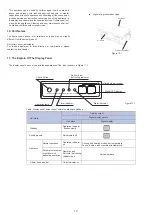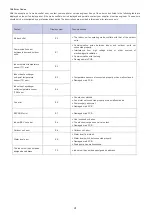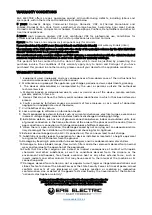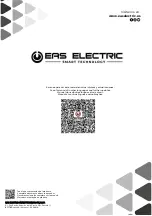
Figure 14.2
Figure 14.1
Figure 14.3
Caution
• Do not dry out the air filter under direct sunshine or with fire.
• The air filter should be installed before the unit body
installation.
3. Re-install the air filter.
4. Install and close the air inlet grille by reversing steps 1 and 2, and
connect the control box cables to the corresponding terminals in
the main body.
Maintenance before stopping using the unit for a long time
(e.g., at the end of a season)
a. Let the indoor units run in fan only mode for about half a day to
dry the interior of the unit.
b. Clean the air filter and indoor unit casing.
c. Refer to “Cleaning the air filter" for details. Install cleaned air
filters back in their original positions.
d. Turn off the unit with the ON/OFF button on the remote
controller, and then unplug it.
Caution
• When the power switch is connected, some energy will be
consumed even if the unit is not running. Disconnect the
power to save energy.
• A degree of dirt will accumulate when the unit has been used
several times, which will require cleaning.
• Take of the batteries from the remote controller.
Maintenance after a long period of non-use
a. Check for and remove anything that might be blocking the inlet
and outlet vents of the indoor units and outdoor units.
b. Clean the unit casing and clean the filter. Refer to "Cleaning
the filter" for instructions. Re-install the filter before running the
unit.
c. Turn on the power at least 12 hours before you want to use the
unit to ensure it works properly. As soon as the power is turned
on, the remote control display appears.
Symptom 2: The unit emits white mist
White mist is generated and emitted when the unit starts to
operate in a very humid environment. This phenomenon will stop
once the humidity in the room is reduced to normal levels.
The unit occasionally emits white mist when it runs in heating
mode. This occurs when the system finishes periodic defrosting.
Moisture that may accumulate on the unit's heat exchanger coil
during defrosting becomes mist and is emitted from the unit.
Symptom 4: Dust is emitted from the unit
This can occur when the unit first runs after a long idle period.
Symptom 5: The unit gives off a strange odor
If smells such as those of strong-smelling food or tobacco smoke
are present in the room, they can enter the unit, leave trace
deposits on the unit's internal components, and later be emitted
from the unit.
16. Troubleshooting
16.1 General
Sections 16.2 and 16.3 describe some initial troubleshooting
steps that can be taken when an error occurs. If these steps do
not resolve the issue, arrange for a professional technician to
investigate the problem. Do not attempt further investigations or
troubleshooting yourself.
If any of the following errors occur, power the unit off, contact a
professional technician immediately and do not attempt
troubleshooting yourself:
a. A safety device such as a fuse or circuit breaker frequently
blows/trips.
b. An object or water enters the unit.
c. Water is leaking from the unit.
Caution
• Do not attempt to inspect or repair this unit by yourself.
Arrange for a qualified technician to carry out all servicing and
maintenance.
15. Symptoms That Are Not Faults
The following symptoms may be experienced during the normal
operation of the unit and are not considered faults. Note: If you are not
sure whether a fault has occurred, contact your supplier or service
engineer immediately.
Symptom 1: The unit will not run
Symptom: When the ON/OFF button on the remote controller is
pressed, the unit does not immediately start running.
Cause: to protect certain system components, system start-up or
re-start is intentionally delayed for up to 12 minutes under some
operating conditions. If the OPERATION LED on the unit's panel
is lighting, the system is working normally and the unit will start
after the intentional delay is complete.
Heating mode is running when the following panel lights are on:
operation and the "DEF./FAN LED indicator.
Cause: the indoor unit activates protective measures because of
the low outlet temperature.
21
Loosen the bolts and
dismantle the filter.
Summary of Contents for Gama CND
Page 2: ......






































